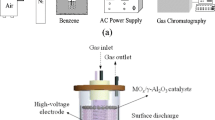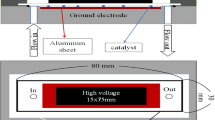Abstract
In this study, post plasma-catalysis degradation of mixed volatile organic compounds (benzene, toluene, and xylene) has been performed in a hybrid surface/packed-bed discharge plasma reactor with Ag-Ce/g-Al2O3 catalyst at room temperature. The effect of relative air humidity on mixed VOCs degradation has also been investigated in both plasma-only and PPC systems. In comparison to the plasma-only system, a significant improvement can be observed in the degradation performance of mixed VOCs in PPC system with Ag-Ce/γ-Al2O3 catalyst. In PPC system, 68% benzene, 89% toluene, and 94% xylene were degraded at 800 J·L–1, respectively, which were 25%, 11%, and 9% higher than those in plasma-only system. This result can be attributed to the high catalytic activity of Ag-Ce/γ-Al2O3 catalyst to effectively decompose O3 and lead to generating more reactive species which are capable of destructing the VOCs molecules completely. Moreover, the presence of Ag-Ce/γ-Al2O3 catalyst in plasma significantly decreased the emission of discharge byproducts (NOx and O3) and promoted the mineralization of mixed VOCs towards CO2. Adding a small amount of water vapor into PPC system enhanced the degradation efficiencies of mixed VOCs, however, further increasing water vapor had a negative impact on the degradation efficiencies, which was primarily attributed to the quenching of energetic electrons by water vapor in plasma and the competitive adsorption of water vapor on the catalyst surface. Meanwhile, the catalysts before and after discharge were characterized by the Brunauer-Emment-Teller and X-ray photoelectron spectroscopy.

Similar content being viewed by others
References
Chang M B, Lee C C. Destruction of formaldehyde with dielectric barrier discharge plasmas. Environmental Science & Technology, 1995, 29(1): 181–186
Chang J S. Recent development of plasma pollution control technology: A critical review. Science and Technology of Advanced Materials, 2001, 2(2): 571–576
Marotta E, Callea A, Rea M, Paradisi C. DC corona electric discharges for air pollution control. Part 1. Efficiency and products of hydrocarbon processing. Environmental Science & Technology, 2007, 41(16): 5862–5868
Aerts R, Tu X, Van Gaens W, Whitehead J C, Bogaerts A. Gas purification by nonthermal plasma: A case study of ethylene. Environmental Science & Technology, 2013, 47(12): 6478–6485
Mizuno A, Kisanuki Y, Noguchi M, Katsura S. Indoor air cleaning using a pulsed discharge plasma. IEEE Transactions on Industry Applications, 1999, 35(6): 1284–1288
Wang T C, Qu G Z, Yan Q H, Sun Q, Liang D, Hu S. Optimization of gas-liquid hybrid pulsed discharge plasma for p-nitrophenol contaminated dredged sediment remediation. Journal of Electro-statics, 2015, 77: 166–173
Bo Z, Yan J, Li X, Chi Y, Cen K. Nitrogen dioxide formation in the gliding arc discharge-assisted decomposition of volatile organic compounds. Journal of Hazardous Materials, 2009, 166(2–3): 1210–1216
Liang W J, Li J, Li J X, Zhu T, Jin Y Q. Formaldehyde removal from gas streams by means of NaNO2 dielectric barrier discharge plasma. Journal of Hazardous Materials, 2010, 175(1–3): 1090–1095
Yamamoto T, Tamanathan K, Lawless P A. Control of volatile organic compounds by an ac energized ferroelectric pellet reactor and a pulsed corona reactor. IEEE Transactions on Industry Applications, 1992, 28(3): 528–534
Jiang N, Guo L J, Shang K F, Lu N, Li J, Wu Y. Discharge and optical characterizations of nanosecond pulse sliding dielectric barrier discharge plasma for volatile organic compound degradation. Journal of Physics. D, Applied Physics, 2017, 50(15): 155206
Jiang N, Lu N, Shang K, Li J, Wu Y. Innovative approach for benzene degradation using hybrid surface/packed-bed discharge plasmas. Environmental Science & Technology, 2013, 47(17): 9898–9903
Tang X J, Feng F D, Ye L L, Zhang X, Huang Y, Liu Z, Yan K. Removal of dilute VOCs in air by post-plasma catalysis over Agbased composite oxide catalysts. Catalysis Today, 2013, 211: 39–43
Einaga H, Ogata A. Catalytic oxidation of benzene in the gas phase over alumina-supported silver catalysts. Environmental Science & Technology, 2010, 44(7): 2612–2617
Zhu X B, Gao X, Qin R, Zeng Y, Qu R, Zheng C, Tu X. Plasmacatalytic removal of formaldehyde over Cu-Ce catalysts in a dielectric barrier discharge reactor. Applied Catalysis B: Environmental, 2015, 170-171: 293–300
Ding H X, Zhu A M, Lu F G, Xu Y, Zhang J, Yang X F. Lowtemperature plasma-catalytic oxidation of formaldehyde in atmospheric pressure gas streams. Journal of Physics. D, Applied Physics, 2006, 39(16): 3603–3608
Oda T, Takahashi T, Kohzuma S. Decomposition of dilute trichloroethylene by using nonthermal plasma processing-frequency and catalyst effects. IEEE Transactions on Industry Applications, 2001, 37(4): 965–970
Karuppiah J, Reddy E L, Reddy P M, Ramaraju B, Karvembu R, Subrahmanyam Ch. Abatement of mixture of volatile organic compounds (VOCs) in a catalytic non-thermal plasma reactor. Journal of Hazardous Materials, 2012, 237–238: 283–289
Morent R, Dewulf J, Steenhaut N, Leys C, Van Langenhove H. Hybrid plasma-catalyst system for the removal of trichloroethylene in air. Journal of Advanced Oxidation Technologies, 2006, 9(1): 53–58
Zhu X B, Liu S Y, Cai Y X, Gao X, Zhou J, Zheng C, Tu X. Postplasma catalytic removal of methanol over Mn-Ce catalysts in an atmospheric dielectric barrier discharge. Applied Catalysis B: Environmental, 2016, 183: 124–132
Fan X, Zhu T, Sun Y, Yan X. The roles of various plasma species in the plasma and plasma-catalytic removal of low-concentration formaldehyde in air. Journal of Hazardous Materials, 2011, 196 (196): 380–385
Einaga H, Ibusuki T, Futamura S. Performance evaluation of a hybrid system comprising silent discharge plasma and manganese oxide catalysts for benzene composition. IEEE Transactions on Industry Applications, 2001, 37(5): 1476–1482
Jiang N, Hu J, Li J, Shang K, Lu N, Wu Y. Plasma-catalytic degradation of benzene over Ag-Ce bimetallic oxide catalysts using hybrid surface/packed-bed discharge plasmas. Applied Catalysis B: Environmental, 2016, 184: 355–363
Chen H L, Lee H M, Chen S H, Chang M B, Yu S J, Li S N. Removal of volatile organic compounds by single-stage and twostage plasma catalysis systems: A review of the performance enhancement mechanisms, current status, and suitable applications. Environmental Science & Technology, 2009, 43(7): 2216–2227
Birdsall C M, Jenkins A C, Spadinger E. Iodometric determination of ozone. Analytical Chemistry, 1952, 24(4): 662–664
Zhang S, Jia L, Wang W C, Yang D Z, Tang K, Liu Z J. The influencing factors of nanosecond pulse homogeneous dielectric barrier discharge in air. Spectrochimica Acta. Part A: Molecular and Biomolecular Spectroscopy, 2014, 117: 535–540
Mei D H, Zhu X B, He Y L. Plasma-assisted conversion of CO2 in a dielectric barrier discharge reactor: understanding the effect of packing materials. Plasma Sources Science & Technology, 2015, (24): 015011
Aba’a Ndong A C, Zouzou N, Benard N. Geometrical optimization of a surface DBD powered by a nanosecond pulsed high voltage. Journal of Electrostatics, 2013, 71(3): 246–253
Zhu X B, Gao X, Yu X N. Catalyst screening for acetone removal in a single-stage plasma-catalysis system. Catalysis Today, 2016, (256): 108–114
Durme J V, Dewulf J, Leys C. Combining non-thermal plasma with heterogeneous catalysis in waste gas treatment: A review. Applied Catalysis B: Environmental, 2008, 78(3–4): 324–333
Skoda M, Cabala M, Matolinova I, Skála T, Veltruská K, Matolín V. A photoemission study of the ceria and Au-doped ceria/Cu(111) interfaces. Vacuum, 2009, 84(1): 8–12
Ogata A, Ito D, Mizuno K, Kushiyama S, Gal A, Yamamoto T. Effect of coexisting components on aromatic decomposition in a packed-bed plasma reactor. Applied Catalysis A, General, 2002, 236 (1–2): 9–15
Futamura S, Zhang A, Einaga H, Kabashima H. Involvement of catalyst materials in nonthermal plasma chemical processing of hazardous air pollutants. Catalysis Today, 2002, 72(3–4): 259–265
van Veldhuizen E M. Electrical Discharges for Environmental Purposes: Fundamentals and Applications. New York: Nova Science Publishers, 2000
Durme J V, Dewulf J, Sysmans W, Leys C, Langenhove H V. Efficient toluene abatement in indoor air by a plasma catalytic hybrid system. Applied Catalysis B: Environmental, 2007, 74(1–2): 161–169
Cvetanovic R J. Evaluated chemical kinetic data for the reactions of atomic oxygen O(3P) with understand hydrocarbons. Journal of Physical and Chemical Reference Data, 1987, 16(2): 261–321
Lias S G. Ionization energy evaluation, In: NIST Standard Reference Database. Maillard W G, Linstrom P J, eds. National Institute of Standard and Technology, Gaithersburg, MD, 2006
Acknowledgements
The authors thank the National Natural Science Foundation of China (Nos. 51507026 & 51177007), General Financial Grant from the China Postdoctoral Science Foundation (No. 2015M580223), Special Financial Grant from the China Postdoctoral Science Foundation (No. 2016T90221), and Dalian University of Technology Fundamental Research Fund (No. DUT15RC (3)030).
Author information
Authors and Affiliations
Corresponding author
Rights and permissions
About this article
Cite this article
Guo, L., Jiang, N., Li, J. et al. Abatement of mixed volatile organic compounds in a catalytic hybrid surface/packed-bed discharge plasma reactor. Front. Environ. Sci. Eng. 12, 15 (2018). https://doi.org/10.1007/s11783-018-1017-z
Received:
Revised:
Accepted:
Published:
DOI: https://doi.org/10.1007/s11783-018-1017-z




